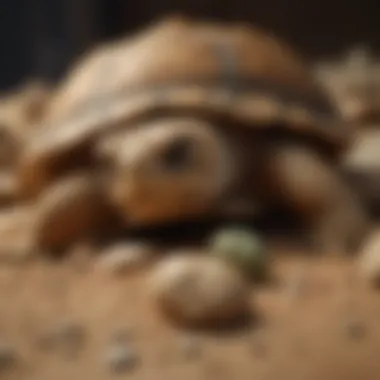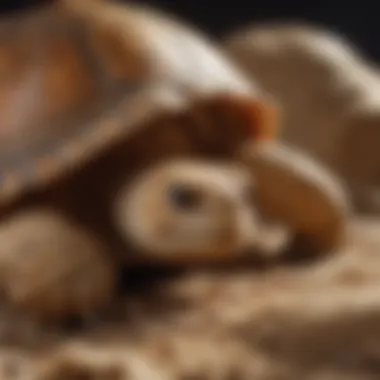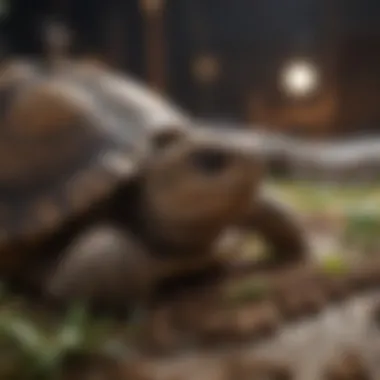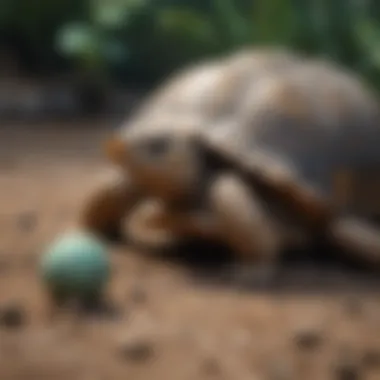Understanding Sulcata Tortoise Bedding: Essential Guide


Intro
Choosing the right bedding for sulcata tortoises is a significant aspect of their overall care. A well-selected bedding material not only fulfills practical functions but also shapes the environment of these unique reptiles. As sulcata tortoises are known for their impressive size and distinct behaviors, their habitat must be properly suited to bolster both their physical health and psychological well-being. This section articulates essential care tips to create suitable surroundings for sulcata tortoises, incorporating the specifics of bedding selection, cage arrangements, and hygiene protocols crucial for optimal living conditions.
Care Tips
Daily Care Routines
Daily interaction with sulcata tortoises plays a crucial role. It encourages them to be more active and less stressed. Fresh bedding contributes to overall cleanliness and helps in monitoring health. A daily check of the bedding can reveal issues like soiling or mold.
Cage Setup and Maintenance
An effective cage setup enables your sulphur tortoise to thrive. It is advisable to use a base layer of absorbent substrate like organic coconut coir or organic topsoil, which helps in providing stability in temperature and moisture retention. To avoid harmful bacteria, deep bedding layers can be beneficial.
Hygiene and Cleaning Practices
Cleaning practices are paramount for sustaining a healthy habitat. Spot cleaning should be done daily to remove any waste. It’s also recommended to fully replace bedding every 2 to 4 weeks, depending on conditions. Use non-toxic cleaners to keep the space safe for the tortoise.
Seasonal Care Adjustments
Weather can influence bedding dynamics. In colder seasons, ensuring your tortoise has warmth is vital; straw or hay may be used to provide insulation. Conversely, lighter materials in warmer months aid in ventilation. Adjust according to temperature fluctuations.
Maintaining proper bedding environment ensures longevity and health for sat sulcata tortoises. Proper habitat halves potential health issues.
Behavioral Insights
Understanding your sulcata tortoise's behaviors can lead to a better care experience for both you and the tortoise. Observing how they react to different bedding materials gives insights into their preferences. If a tortoise often burrows or displays exploration tendencies, adjustable bedding levels may help fulfill these needs.
Common Behavioral Issues and Solutions
Tortoises can show signs of stress in inappropriate environments. A minimalistic bedding style may contribute quicker to stress. Opting for more observable and humanoid materials will enrich their environment. Create a balanced habitat that reflects natural conditions.
Positive Reinforcement Techniques
Using tasty treats can affirm desirable behaviors. Rewarding tortoises when they engage with enriching bedding, perhaps when they explore new materials, helps to forge connections and cognitive growth.
Wellness and Health
Keeping sulcata tortoises healthy is a multi-faceted process. Proper care extends beyond merely providing housing. Each time the bedding is cleaned, routine inspections for signs of illness should be developed.
Identifying Symptoms of Illness
Loose stools or reduced mobility might give signs that your tortoise is unwell. Keeping a log of their health patterns in relation to different bedding can help with patterns analysis and effective care strategies.
Enriching Activities
Enriching activities play a pivotal role in ensuring sat sulcata tortoises maintain positive mental health.
Toys and Playtime Ideas
Designing safe, interactive toys made of safe materials can challenge your tortoise’s curiosity. Objects that promote digging or nudging initiate their true exploratory nature.
Outdoor Activities and Interaction
Offering opportunities for your tortoise outdoors allows greater engagement with space. Supervised outside time enrichshimng their physically interactive experience within different bedding options available.
Implementing the advice outlined in these sections will not only contribute actively to the health of sulcata tortoises. An effective approach towards their habitat enables a lifestyle that suits their natural instincts better. Review methods consistently for continual improvements.
Prologue to Sulcata Tortoises
Overview of Sulcata Tortoises
Sulcata tortoises, also known by the scientific name Centrochelys sulcata, are the largest tortoise species native to Africa. They are notably characterized by their unique, domed carapace and their impressive growth, reaching weights of up to 100 pounds or more. The tortoise can live for many decades, often exceeding 50 years in captivity. Their dietary needs predominately consist of grasses, which drives their natural behavior of grazing.
Understanding the overview of sulcata tortoises is vital for their proper care, particularly in the context of their bedding requirements. Recognizing their natural characteristics informs the best practices associated with their habitat arrangements.


Natural Habitat and Behavior
These tortoises thrive in arid and semi-arid environments in the African savannas and grasslands. The climate exerts a significant influence on their behaviors, grazing and burrowing regularly in search of food and shelter from the sun.
Natively, these tortoises prefer sandy or dry substrate enriched with various vegetation. Because of their nature, replicating this sort of living space in captivity is essential. A suitable bedding setup not only accommodates them physically but also aligns with their instinctual behaviors. Doing so enhances their overall health, encourages exploration, and reduces potential stress related to captivity.
An understanding of their habitat contributes directly to making informed decisions about what kinds of bedding materials to choose. It also aids in tailoring environmental conditions that reflect their wild settings as closely as possible.
Importance of Bedding for Sulcata Tortoises
Bedding serves a primary role in the enclosures of sulcata tortoises. Choosing the right bedding is not just about aesthetics. It impacts the overall well-being of the tortoise. Proper bedding can contribute to health and comfort in considerable ways.
Bedding keeps moisture where needed, controls waste absorption, and protects the tortoises from various health issues. Many owners may not recognize these benefits until issues arise. Selecting a suitable material fills both functional and psychological needs for these reptiles.
Health Benefits of Proper Bedding
Health is foremost when considering the choice of bedding. Proper bedding can effectively manage humidity levels. This is important as humid environments are crucial for sulcata tortoises. They can develop respiratory problems when humidity is too low or too high. A suitable bedding choice helps in maintaining the right moisture balance in the habitat.
Depending on its composition, bedding can prevent skin infections and injuries. For instance, if the substrate is too abrasive, the tortoise can suffer from skin irritation. In contrast, softer materials reduce the risk of scrape injuries and promote healing.
Other Health Factors to Consider:
- Temperature Control: Some bedding materials help maintain warmth. They can create microenvironments favorable for temperature regulation.
- Bacteria and Fungi Resistance: Selecting suitable bedding can minimize bacterial and fungal growth, ensuring a cleaner environment.
Using inadequate or inappropriate bedding might lead to diseases.
Therefore, veterinary costs can rise considerably. Hence, proper selection is an investment in the grace of ongoing care.
Bedding's Role in Comfort and Security
Comfort forms the foundation for any habitat. Sulcata tortoises require an environment that resembles their natural setting. Proper bedding mimics both the appearance and texture of their natural habitat.
When the bedding is comfortable, sulcata tortoises display normal behaviors. They can roam and explore without struggle. This term “security” also extends to how they feel within their enclosure. In a familiar environment, tortoises exhibit lowered stress levels and display more natural activity.
Therefore, soft materials in bedding can buffer against impact when the tortoises retreat or burrow. This combination of comfort and security fosters a healthier behavioral state in tortoises, contributing further to their well-being.
Comfort in the habitat is linked to better overall health outcomes for sulcata tortoises.
Understanding how bedding impacts comfort and security can greatly enhance the life of a sulcata tortoise. A thoughtful choice makes all the difference, connecting the illvies of holistic care to the physical space provided for these reptiles.
Types of Bedding Materials
Choosing the right bedding materials for sulcata tortoises is crucial. It directly impacts their well-being and environment. Each material has specific benefits and considerations. Understanding these elements allows owners to make informed choices. The right bedding can also complement the tortoise's natural habitat and behavior.
Coconut Coir
Coconut coir is a popular bedding choice. It is derived from the husks of coconuts. This material is known for excellent moisture retention. It creates a humid environment without becoming overly wet. This is essential for sulcata tortoises as they prefer a dry, but not dehydrated, habitat. Coconut coir is also environmentally friendly, promoting a sustainable approach to tortoise care. Additionally, it is often less dusty compared to other bedding options, reducing the likelihood of respiratory issues.
Aspen Shavings
Aspen shavings are another viable option for sulcata bedding. They provide a soft surface that's comfortable for the tortoise. Aspen is found in various markets as it is readily available and cost-effective. Importantly, it is low in dust, which helps maintain clean air in the enclosure. While they absorb moisture, they should be replaced regularly to avoid mold buildup. Owners should also note that aspen shavings are not as adept at retaining humidity compared to other materials, so they may require additional moisture sources in extremely dry environments.
Sandy Substrate
Sandy substrate mimics the natural environment of sulcata tortoises. It encourages natural digging behavior which is vital for the turtles. The sand should be clean, and not contain fine dust particles that can be ingested. This material offers good drainage as well, helping to keep the environment dry. However, one should watch for loose sand in the tortoises' lungs if ingested in larger quantities. It may also cause minor complications, considering that they might consume it by accident.
Cypress Mulch
Cypress mulch is another strong contender in toroise bedding. This material has natural properties to resist mold and decay, suiting the humid environments some captive tortoises need. Also, it presents an aromatic presence that many animal owners appreciate. The mulch is gentle on their feet, reducing the chances of injury. However, it is still necessary to monitor humidity levels since too much can lead to unhealthy environments.
Commercial Tortoise Beddings
Commercial tortoise bedding products offer convenience and variability for owners. These products are often blended to address multiple needs. They combine elements from the aforementioned bedding choices. Some brands create formulas designed to maintain the necessary moisture and provide comfortable support. When opting for these readily available options, inspecting ingredient lists is recommended to ensure that there are no harmful additives. Such beds may range higher in price but can often eliminate the guesswork associated with DIY solutions.
Choosing the right material is vital to keeping your sulcata tortoise healthy and thriving.


Factors to Consider When Choosing Bedding
Choosing the right bedding for sulcata tortoises is fundamental to their health and happiness. To make an informed decision, it is vital to consider several factors. Each consideration affects different aspects of the tortoise’s life in captivity. So, when deciding on bedding, one needs to look at the overall setup, taking multiple variables into account.
Age and Size of the Tortoise
When selecting bedding, the age and size of the tortoise are crucial. Hatchlings require a finer substrate that reduces risks of ingesting material while they root around. A coarser material may not be ideal for the small size of baby tortoises. In contrast, adults can safely navigate rugged substrates, but they will benefit from materials that accommodate their larger size.
Key Points:
- Hatchlings: Use fine substrates like coconut coir.
- Adults: Can manage coarse materials like cypress mulch but must have an enriched environment to encourage natural behaviors.
A well-sized space with the proper material can strengthen their limbs and promote healthy activity, crucial for their development.
Humidity and Temperature Requirements
Sulcata tortoises are sensitive to humidity and temperature levels. When choosing bedding, it is neccessary to consider the moisture retention qualities of the materials. Also, since these tortoises are desert-dwelling, excessive humidity can lead to health issues. Cocoa coir can retain moisture well but may create problems if not combined properly with dry substrates.
Best Practices:
- Monitor humidity regularly, with ideal around 30%-40% for adults.
- Choose warm bedding substrate with good airflow, preventing hyper-humid conditions.
Conclusion, selecting b](edding material must balance moisture retention and airflow. Anything too moist may lead to the growth of bacteria and fungi, which can affect the tortoise's health.
Ease of Maintenance
Bedlinng's ease of maintenance is another crucial aspect to think about. It is not only about choosing the right bedding but keeping it clean. Some materials break down quickly and need frequent changing. Commercial tortoise bedding tends to offer better maintenance properties, being designed for easy cleaning. Efficient cleaning means less workload for the pet owner and better living conditions for the tortoise.
Maintenance Tips:
- Choose substrates that do not break down rapidly, reducing the frequency of changes.
- Spend some time cleaning dirty spots often to minimize smell and allow for a healthy habitat.
By carefully assessing each of these factors, tortoise owners can optimize the bedding choice, ensuring their sulcata tortoises thrive in their environment.
Bedding Setup in the Enclosure
Setting up bedding in the enclosure of a sulcata tortoise is critical to their overall health and comfort. Proper bedding allows for a space where the tortoise can move, burrow, and exhibit natural behaviors. It's much more than just a base material. The right setup can mimic their wild environments, promoting better mental and physical well-being.
Good bedding improves humidity levels, supports temperature regulation, and serves as a comfortable resting place. A thorough understanding of how to create an effective bedding setup can reduce stress and result in a happier, healthier tortoise.
Creating Layers for Comfort
Creating layers in the enclosure bedding is essential to mimicking the tortoise's natural habitat. Humans use different layers in their own bedding systems for comfort, and tortoises benefit similarly. A well-designed multi-layer bedding setup can improve comfort and create all the environew solutions. Here's how to structure these layers:
- A Bottom Layer: Start with a substrate that allows for drainage while providing strong support. When selecting this, coconut coir can be an efficient first layer, as it holds moisture while becoming less compact over time.
- Intermediate Layer: Add another layer that may include organic matter or leaf litter, facilitating a naturalistic experience. This layer provides texture and is excellent for exploratory behavior.
- Top Layer: Finally, finish off with a topping of finer material, such as aspen shavings. This layer is particularly useful when promoting tactile stimulation and mimics the feel of bound leaves in their natural predicaments.
Take care to adjust the layers depending on the age—hatchlings might require thicker, softer layers while larger sulcata tortoises may prefer less bedding that allows more space for movement. Each layer should be easy to clean, providing both you and your tortoise more peaceful environment.
Designing a Naturalistic Habitat
Designing a naturalistic habitat within the enclosure not only benefits sulcata tortoises physically, but also mentally. A habitat like this replicates the varied components of their native habitat. Elements to consider include:
- Shelter: Use pieces like wood or coconut fiber for hiding spots. This promotes security, enhancing comfort.
- Style: Incorporates plant materials. Ensure these are safe for tortoises. Doing so enriches their environment.
- Ground Texture: Balance hard surfaces with softer ground coverage. Substrate diversity can encourage movement and natural behavior.
A more complex environment allows for exploration and reduces boredom, leading to less anxious and more active tortoises. Experiment piece by piece; different sulcata turtles might enjoy varying layouts.
Remember, a well-structured habitat contributes significantly to a tortoise’s overall happiness and reduces stress, essential for their long-term success as pets.
Creating enriching bedding setups significantly influences a sulcata tortoise's quality of life. Careful attention must go into every layer and design aspect for optimal conditions.
Maintaining Healthy Bedding Conditions
Maintaining healthy bedding conditions is crucial for the well-being of sulcata tortoises. Proper bedding protects tortoises from potential health issues and contributes to their overall comfort. Keeping the bedding clean, dry, and appropriately structured supports the tortoise's natural behaviors and encourages exploration. In addition, it provides a space for burrowing, a common activity for sulcata tortoises in the wild. Creating a suitable environment is not just an aesthetic choice; it significantly impacts their health and quality of life.
Regular Cleaning Routines


Establishing regular cleaning routines ensures a hygienic habitat. Tortoises can become ill if their bedding becomes too dirty or moist. Accumulated waste and bacteria can breed illness, posing a threat to the tortoise's well-being. Cleaning should consist of removing soiled bedding at least once a week or more often if it becomes visibly dirty. A complete change of all bedding materials should happen every few weeks.
In addition to removing waste, a thorough washing of any washable components of their habitat is necessary to limit bacteria growth. This cleaning cycle not only protects the tortoise but also creates a more pleasant environment for both the pet and the owner. Here are some helpful tips for maintaining cleanliness in the bedding setup:
- Remove uneaten food pieces promptly.
- Spot clean daily and conduct a more thorough scrub weekly.
- Replace bedding materials to prevent too much buildup of waste.
Monitoring for Bacterial Growth
Monitoring for bacterial growth is an important aspect of bedding management. Poor heating or consistent moisture can lead to significant bacteria growth, creating a risk of serious infections. Regular checks will ensure the environment remains optimal for the tortoise.
Look for signs such as:
- Foul Odor: An unpleasant smell is often a clear indicator of bacterial activity.
- Discoloration: Changes in color or texture of the substrate may signal mold or bacteria.
- Unusual Behavior: Changes in the tortoise's behavior, like lethargy, can be a stress response related to an unhealthy living condition.
When assessing bedding for signs of bacterial growth, pay attention to humidity levels and temperature. The right levels can minimize bacterial threats. If bacteria growth is detected, it is essential to clean and sterilize the enclosure immediately. Preventive actions boost the tortoise's overall health while maintaining a proper habitat cycle. Incorporating such practices into tortoise care fosters a safe and friendly environment for your pet.
Bedding and Behavioral Impact
Bedding plays a significant role in the varied behaviors of sulcata tortoises. When selecting appropriate bedding, it is important to consider how it affects both exploration and stress levels. This topic also highlights essential aspects of a tortoise's well-being and can impact their overall health.
Exploration and Enrichment
Sulcata tortoises are naturally curious creatures. Providing them with bedding that encourages exploration is critical. Options like coconut coir or cypress mulch not only provide a comfortable substrate but also allow these tortoises to dig and burrow. Utilizing natural materials can stimulate their instinctual behaviors.
- Coconut Coir: This material retains moisture and provides anchorage for digging, aligning with the tortoise's natural behavior in the wild.
- Cypress Mulch: Acts like a dry leaf litter, offering sensory engagement as they navigate through it.
In addition, adding features like rocks, plants, or hiding spots enhances their habitat. These elements add layers of complex interactions that mimic their natural environment. Such an enriched environment contributes positively to their physical and psychological health.
Stress and Anxiety Reduction
Stress management is vital for sulcata tortoises. Stress can adversely impact health, leading to weakened immune systems and other health issues. Effective use of bedding helps create a secure and comfortable space for the tortoise.
- Proper Thickness: Ensure enough depth for burrowing provides that snuggled-in feeling, which gives a safer ambience.
- Regular Changes: Dirty bedding can lead to harboring bacteria, causing stress or potential health problems.
- Appropriate Materials: Hard or uncomfortable substrates can result in stress. Using bedding that replicates their natural habitat can mitigate this.
Common Mistakes in Bedding Choices
Choosing the right bedding for sulcata tortoises involves several considerations. However, many owners make mistakes that can compromise the health and well-being of their pets. Understanding these errors can help mitigate risks and create a safer habitat.
Using Inappropriate Materials
One of the most significant mistakes is using inappropriate materials. Not all bedding options are suitable for sulcata tortoises. For instance, cedar and pine shavings can be harmful due to the aromatic oils they contain. These oils can cause respiratory issues and skin irritation. Instead, many experts recommend substrates like coconut coir and aspen shavings, which are safer alternatives.
Another common error is assuming any substrate that looks natural is acceptable. Some natural materials can retain moisture, leading to bacteria and mold growth. Humid conditions can cause skin infections and respiratory illnesses, putting tortoise health at risk. When selecting bedding, prioritize dry and well-ventilated options.
Tip: Stick to materials designed specifically for reptile habitats to avoid long-term health issues.
Neglecting Bedding Changes
Proper maintenance of tortoise bedding is crucial. Many owners overlook the need for regular bedding changes, which can lead to poor living conditions. Over time, bedding can become soiled, damp, or moldy, posing health risks.
Inadequate cleaning allows pathogens to thrive, increasing the risk of infections. Additionally, an unkempt habitat may drive stress and anxiety in sulcata tortoises. Signs of distress can manifest in various ways, such as decreased activity level or abnormal behavior.
The optimal approach is to establish a consistent cleaning routine. Frequently replace the bedding material and ensure thorough cleaning of the enclosure itself. This not only promotes a hygienic environment but also enhances the tortoise's quality of life.
By being aware of these common mistakes and addressing them, sulcata tortoise owners can create a healthy and thriving habitat for their cherished reptiles. Regular checks and informed choices lead to more fulfilling lives for both the tortoises and their caretakers.
Closure
The conclusion serves as a vital component of this article. It ties together all the essential elements discussed and reinforces the significance of appropriate bedding for sulcata tortoises. By recapping the key points, it allows readers to reflect on the importance of selecting the right materials to create a suitable habitat.
Summary of Key Points
Understanding the needs of sulcata tortoises hinges on recognizing how bedding affects their health and comfort. Key takeaways from this article include:
- Bedding Material Variety: Different types of bedding, such as coconut coir, aspen shavings, and sandy substrates, offer unique benefits.
- Health Considerations: Proper bedding contributes to the tortoise's overall well-being, reducing stress and preventing harmful bacterial growth.
- Behavioral Impacts: Enriching the environment with appropriate bedding materials fosters natural behaviors like exploration and digging.
- Maintenance Requirements: Regular cleaning routines are crucial in maintaining a healthy living space.
- Common Pitfalls: Avoiding incorrect materials and neglecting bedding changes can lead to serious health issues for your tortoise.
Final Thoughts on Bedding Choices
Choosing the right bedding material is not merely a matter of preference; it significantly impacts the health and happiness of sulcata tortoises. Owners should carefully consider both the species' natural habitat and the specific needs of their individual tortoises. Conduct thorough research and evaluate available options before making a decision.
Ultimately, providing a comfortable and safe environment through appropriate bedding choices sets the foundation for a thriving sulcata tortoise. It is about ensuring their present wellness while being mindful of their future as well.
For further exploration on sulcata tortoises, check out Wikipedia for in-depth information.















